#medieval religion
Text
I begin my PhD at the end of the month and will be doing a Lot of reading on medieval religious women, ascetic practices and affective meditation, bioarchaeology, & on philosophy (both medieval & modern) surrounding pain, suffering, sensation, and sadomasochism. I think I might post recommendations and links to articles, etc. if folks might be interested(?). I'm very pro knowledge sharing and free education, so if you're at all interested, feel free to pop me a message and I can keep an eye out for articles that might specifically interest you.💞
#academic#phd#studyblr#philosophy#history#education#medieval#medieval women#medieval christianity#bioarchaeology#archaeology#asceticism#ascetic practices#affective meditation#nun#nuns#anchorites#anchoresses#anchorhold#cloister#suffering#pain#sensation#medieval religion#medievalist#medieval history#medieval philosophy
10 notes
·
View notes
Text
15 notes
·
View notes
Link
The Stripping of the A... Duffy, Eamon Best Price: $22.07 Buy New $18.53 (as of 02:52 UTC - Details) The Cambridge academic Eamon Duffy first published The Stripping of the Altars: Traditional Religion in England, 1400-1580 in 1992. The book’s premise is that the Medieval religion of England, including all of the bells, incense, candles, veneration of saints and pageantry of a highly liturgical religion, was still practiced day in and day out throughout England with vigor and belief when a top-down cultural revolution dissolved this essence of English life over a couple of generations. Duffy explores in detail the … Continue reading →
0 notes
Text
20,000 words milestone
Since 20,000 words written is a bit of a milestone, here is some no context information about the 13th century…
Here are two religious manuscripts that may or may not be relevant:
Codex Gigas (aka The Devil's Bible)
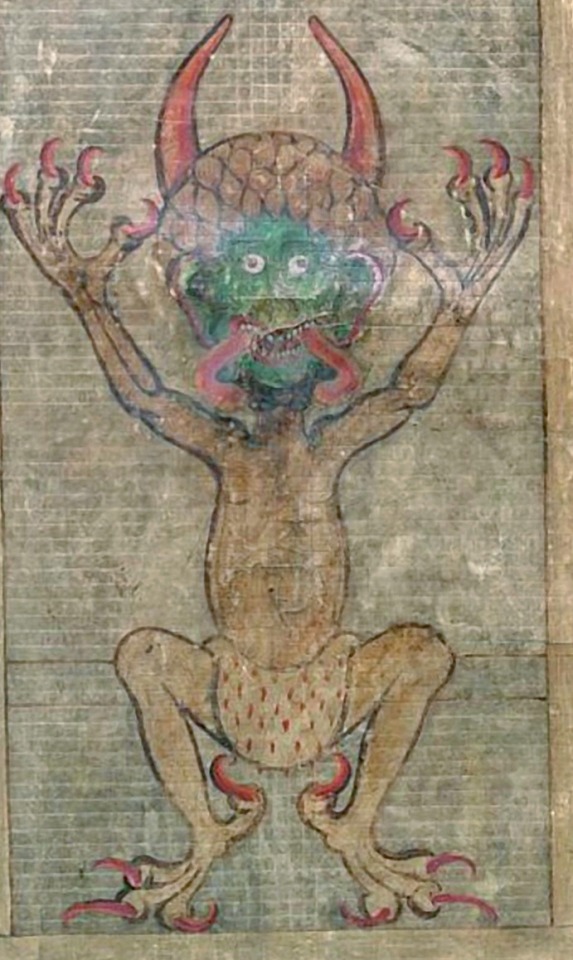
^ So, this is a depiction of the devil found in a codex (basically an old handwritten book) from early 13th century, what is now the, Czech Republic.
Here is the Wikipedia article. It's written in Latin, which I recently discovered is a language you can learn on Duolingo... probably not 13th century Latin though.
Aja'ib al-Makhluqat (The Wonders of Creatures and the Marvels of Creation)

^ This is the Archangel Gabriel who is looking quite stylish and colourful. The picture itself is from a 14th century manuscript, but the original work was written by Zakariya al-Qazwini in the 13th.
It was written in Arabic, which as far as I can tell would have been in 'Classical Arabic' which differs somewhat from the 'Modern Standard Arabic' used today.
I can't remember how I found this, but here is the Wikipedia article.
---
So, 13th century England or 13th century Scotland...
Kingdom of Alba
Well, I haven't been to either England or Scotland, but neither existed as we know them in the 13th century. Something that did exist from 900AD till 1296AD was the Kingdom of Alba. Which seems to me to just be the Scottish Gaelic word for... Scotland.
There is a lot of information about Scotland in the High Middle Ages, far more than I had time or energy to read about. But the King during the 1240's was:

^ Alexander II (1198 - 1249), King of Scots. And here is his Wikipedia article, and that's his seal.
He was the "only Scottish king to take his invasion force all the way to the south coast of England", and signed the "Treaty of York (1237) which defined the boundary between England and Scotland".
So, the 13th century wasn't boring, if you are a historian... which I am not.
Getting slightly back on topic:
Church architecture from 13th century Scotland has a few examples still standing that are easy finds.

^ Dunblane Cathedral, in Dunblane, Scotland, has been restored... but would have been restored using materials and techniques that would make it still a useful example of a 13th century church. (Even though it was originally built between the 11th and 15th centuries... like I said, I'm not a historian.)
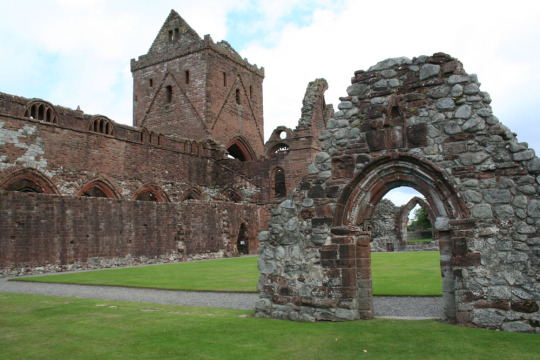
^ The ruins of Sweetheart Abbey, in New Abbey, Scotland, was founded in the late 13th century. I think it's held up pretty well, considering it has been abandoned since 1624.

^ My personal favourite: The ruins of Elgin Cathedral, in Elgin, Scotland. Built in 1224 on land granted by the aforementioned King Alexander II.
I mean, it had a tendance to be burnt down... at least three times... so it's probably more of a 15th century example, but it's pretty.
---
Assorted people of the 13th century:
Francis of Assisi
Francis of Assisi (1181 - 1226), was a 13th century monk who lived and died in what we would now think of as Italy. He is not relevant to what I am writing, however his Wikipedia page has a detailed painting of what a 13th century monk would wear… although it was painted in the 17th century so…

^ Francis of Assisi.
Hugh of Saint-Cher
Hugh of Saint-Cher (1200 - 1263), was another 13th century monk, this time a Bishop, who…wore glasses! That’s it, that's why I find him interesting. Born in what is now France and dying in what is now Italy, the painting of him wearing a pair of eyeglasses is one of the (if not the) first depictions we have of someone who wore reading glasses. Sunglasses were also invented in roughly the same timeframe in China.

---
Miscellaneous...
While not particularly relevant, I of course spent some time looking at fashion trends of the 13th century... and learning of the existence of sumptuary laws, which are also not relevant but confirm the existence of the fashion police.
And I have yet to finish watching the BBC docuseries on 'How To Build A 13th Century Castle'.
I'll end with: Medieval names we can all enjoy...
#13th century#medieval history#13th century fic#medieval scotland#medieval religion#apparently you can take me out of academia but...
0 notes
Text

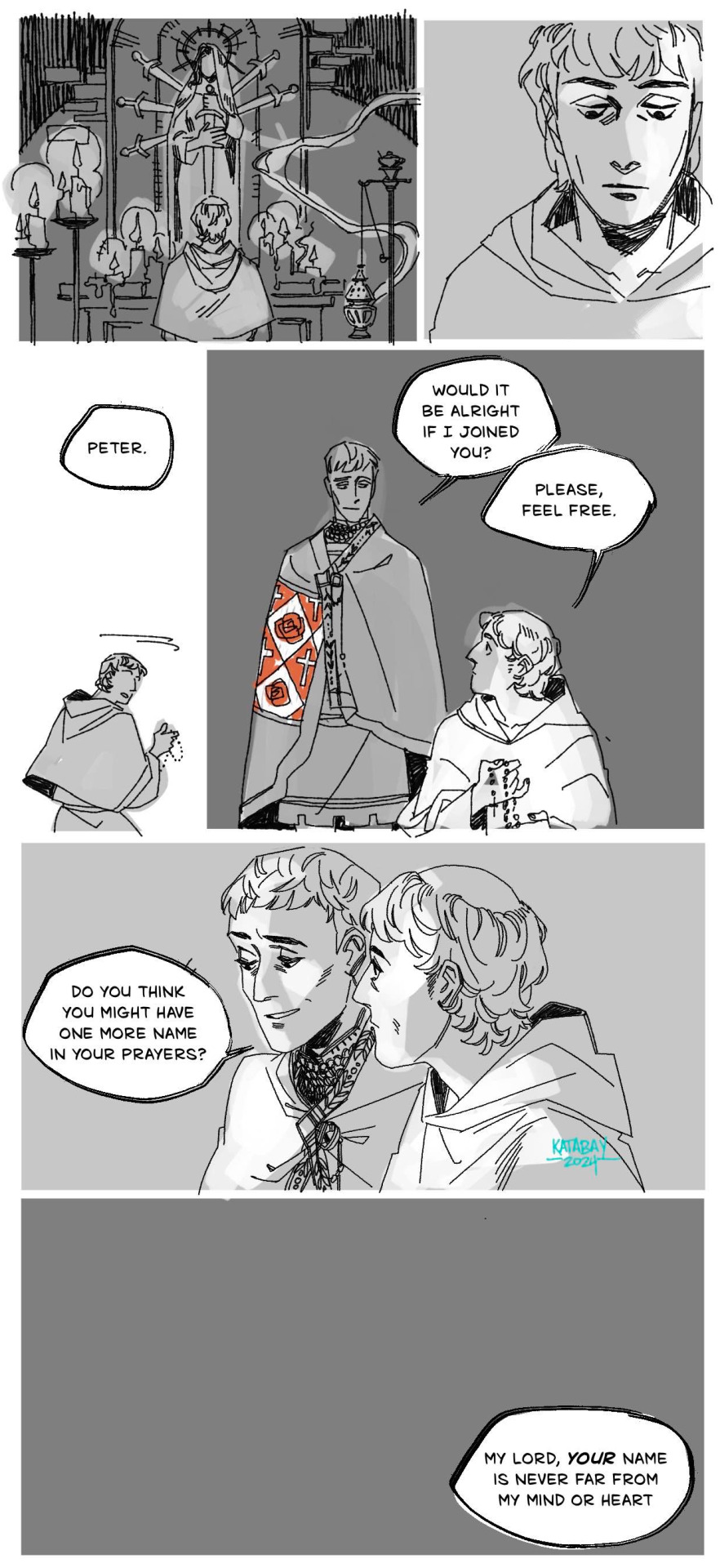
LIPS, MIND, HEART. KNIGHTS, VIOLENCE. CONVICTION.
some. kind of idea. I might try and tackle next year. tragically, I need to do research on the medieval economy lmao
the first knight is the youngest of the pair, eager for war glory. the priest is thinking of murdering him on his return. the eldest brother is thinking of deserting the army en route for a coastal fishing village where no one will know his name.
the statue with all the swords is our lady of sorrows, traditionally fashioned with seven swords. I've decided to do three on each side and the seventh held in front instead of the usual 3 on one side and 4 on the other split I see so that it matches that other panel's sword/hand position :)))
⭐ places I’m at! bsky / pixiv / pillowfort /cohost / cara.app / insta / tip jar!
#generic medieval tag#komiks tag#for the non catholics and the 'i forgot everything in sunday school' crowd: lips/mind/heart = sign of the cross#anyway more importantly. knights and religion and war violence do not exist independently of each other. blood on EVERYONE'S hands#the poetic chivalric knight is still part of the same structure that the historical knights were etc etc. and that's interesting!#fun interdisciplinary dialogue or whatever. much to chew on
759 notes
·
View notes
Text
It's fascinating to me that for our modern (at least on European-influenced societies) thinking, the classical Roman way of life is so familiar. When you read about it, the rethoric of the speeches feels modern, a society based on contracts and laws and litigation, with public works, a state bureucracy and standing army and trade economy and even spectator sports, a concept of philosophy separated from religious dogma and tradition, with even a limited understanding of a government by 'the people' and 'citizenship', even the names all sound familiar even if in completely different contexts, and no wonder since they inspired our current politics.
This all in contrast to medieval feudalism, which is completely alien to me. A society created upon family connections and oaths of fealty and serfdom with no such thing as an overarching state, not even kingdoms were any more real than a title one person holds, and all held together completely, utterly, to an extent I cannot emphasize enough, by the institution of the Church and the Christian faith. In a way we just aren't used today in our secular world. I simply cannot overstate how everything, every single thing, was permeated by faith in the Medieval worldview and the Church which took its power from it, we have an understanding of it but I think people just don't realize it.
#cosas mias#this is a very silly example so bear with me#the other day I was watching some Manor Lords playthroughs#and a guy was complaining his medieval village wasn't growing#it was because no matter all the economic resources it had it didn't have a church#of course that for those people a place without a church is a non-place to start with never mind anything else#(and even the game oversimplifies that)#what I mean by these stupid tags is that we see religion as something private... for them it meant literally EVERYTHING#in a way we don't understand sure we can imagine a city without imagining churches... for someone on the middle ages#a Place was a Place where a Church was
994 notes
·
View notes
Text

The Boat of Souls (Dante's Divine Comedy) by Gustave Doré
#gustave doré#art#dante#virgil#the divine comedy#divine comedy#purgatory#purgatorio#dante alighieri#boat#souls#angel#angels#christianity#christian#religion#earthly paradise#terrestrial paradise#religious art#religious#medieval#middle ages#europe#european#psalms#psalm#singing
773 notes
·
View notes
Text
you know, i can handle a little bit of fun "Nandor is dumb" talk, but i have a net-zero tolerance for any implication that Nandor is not educated.
Nandor would have been incredibly educated in his lifetime.
even (or especially) as a soldier in the Islamic World. being a soldier was more like getting sent to boarding school that's also a military camp. they weren't just concerned with creating loyal fodder for war. they were building the next government officials, generals, accountants, advisors, etc. it was important that young men knew how to read, write, speak multiple languages, learn philosophy...sometimes even studying art and music was mandatory.
if he was nobility (and its most likely he was), take all that shit and multiply it exponentially. Nandor would have been reading Plato at the same age most people are still potty training. he would have been specifically groomed in such a way to not be just a brilliant strategist and warrior, but also diplomate and ambassador of literally the center of scientific and cultural excellence of the age.
so like yeah, he can be a big dummy sometimes, sure. but that bitch is probably more educated than any of us will ever be.
#wwdits#nandor the relentless#Nandor#what we do in the shadows#i think its obvious by how much Nandor loves to read that he grew up educated#it's one of my favorite character traits of his#anyways#this was just your local psa abt the depth of Nandor's character and intelligence#and how the medieval islamic world was like - so much more advanced than it's western counterpart it's hilarious how ppl mischaracterize it#(by hilarious i mean it makes me want to break something)#this was in my drafts lolol what did i read that made me vent this? idk#also 'islamic world' is just a term some historians use to describe a specific geographical location and historical age#kind of how 'western world' is used today#it doesn't mean it's specific to one religion or nation but the broader time and location#meaning that Al Qolindar or Persia or Ilkhanate or w/e you want to call where Nandor came from#the same expectations of education and it's vibrant social/cultural world remain an accurate image of the middle east in the medieval age#if you come from the west like me#think The Forum + The Library of Alexandria + Paris/Florence + and idk anything else u think of when u think of 'Western Excellence'#and then imagine of all of that in one place at one time and then u might get close to what the world Nandor was living in as a human
231 notes
·
View notes
Text
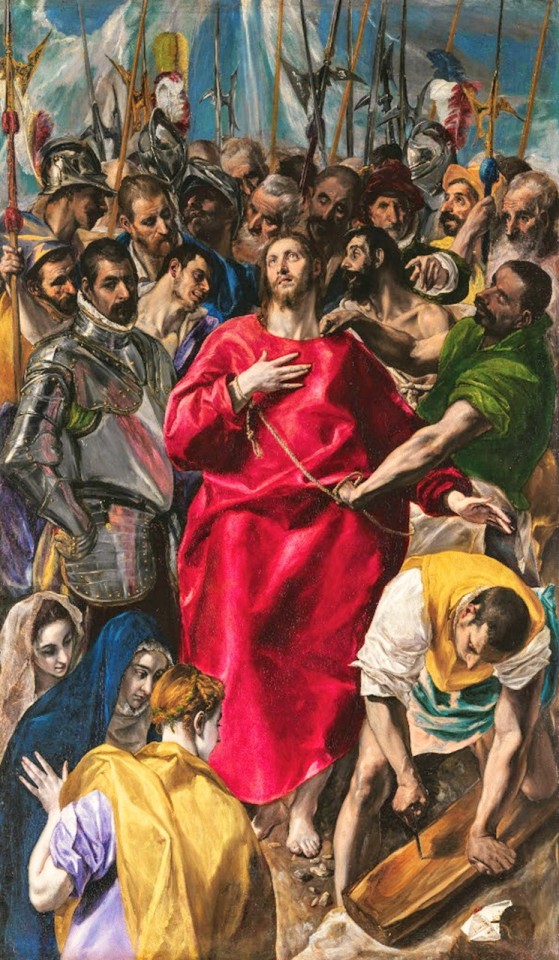
El Greco The Depredation. 1579. Oil on canvas: 285 × 173 cm (112 × 68 in).
#16th century#art history#jesus#history#christianity#oil painting#medieval#spirituality#religion#easter#renaissance#good friday#christ#crucifixion#jesus christ#gothic#el greco#oil on canvas#art#painting#🎨
181 notes
·
View notes
Text
9 notes
·
View notes
Text






I love you Joan Of Arc
#wiredcore#knightcore#medieval#joan of arc#knight armor#knight aesthetic#vintage#morute#religion#chatholic#religious aesthetic#catholic aesthetic#girlblogging
85 notes
·
View notes
Text
Medieval Hermitage atop Katskhi Pillar, in Georgia (South Caucasus), c. 800-900 CE: this church was built during the Middle Ages; it sits atop a limestone column that has been venerated as a "Pillar of Life" for thousands of years
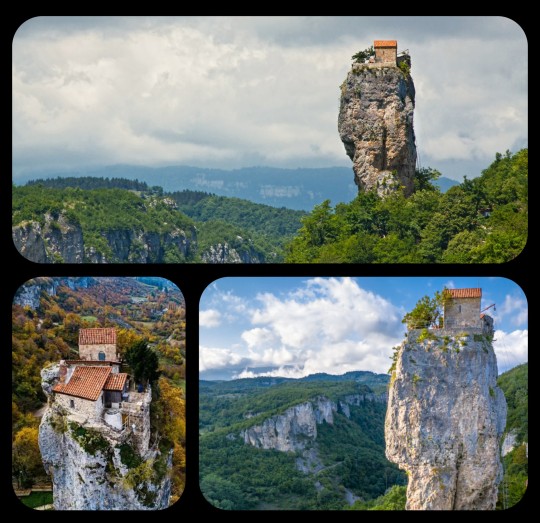
Known as Katskhi Pillar (or Katskhis Sveti), this enormous block of limestone is located in western Georgia, about 10km from the town of Chiatura.
The church that stands atop Katskhi Pillar was originally constructed during the 9th-10th century CE. It was long used as a hermitage for Stylites, who are sometimes referred to as "Pillar Saints" -- Christian ascetics who lived, prayed, and fasted atop pillars, often in total isolation, in an effort to bring themselves closer to God. This tradition originated in Syria during the 5th century CE, when a hermit known as Simeon the Elder purportedly climbed up onto a pillar and then stayed there for nearly 40 years, giving rise (no pun intended) to the Stylites. Stylitism managed to survive for about 1,000 years after its inception, but it gradually began to die out during the late Middle Ages, and by the end of the 16th century, it had essentially gone extinct.
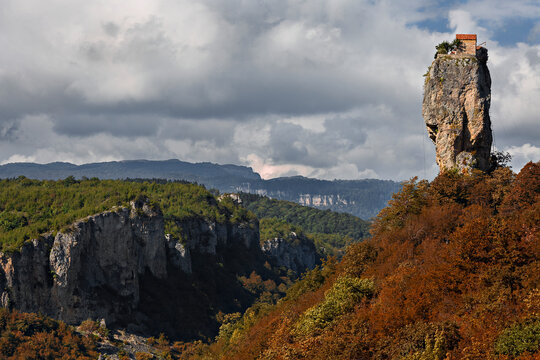
Researchers don't really know how the monks originally gained access to the top of Katskhi Pillar, or how they were able to transport their building materials up to the top of the column. There's evidence that the Stylites were still living at Katskhi Pillar up until the 15th century, but the site was then abandoned shortly thereafter. This was the same period in which Georgia came under Ottoman rule, though it's unclear whether or not that may have played a role in the abandonment of the site.
The hermitage continued to lay abandoned for nearly 500 years after that. No one had been able to gain access to the top of the pillar, and very little was even known about the ruins that lay scattered at the top, as knowledge about the site's origin/history was gradually lost. There are many local legends that emerged as a way to fill in those blanks.
The site was not visited again until July 29th, 1944, when a mountaineer finally ascended to the top of the column with a small team of researchers, and the group performed the first archaeological survey of the ruins. They found that the structure included three hermit cells, a chapel, a wine cellar, and a small crypt; within the crypt lay a single set of human remains, likely belonging to one of the monks who had inhabited the site during the Middle Ages.
A metal ladder (the "stairway to Heaven") was ultimately installed into the side of the pillar, making it much easier for both researchers and tourists to gain access to these ruins.

The hermitage at the top of Katskhi Pillar actually became active again in the early 1990's, when a small group of monks attempted to revive the Stylite tradition. A Georgian Orthodox monk named Maxime Qavtaradze then lived alone at the top of Katskhi Pillar for almost 20 years, beginning in 1995 and ending with his death in 2014. He is now buried at the base of the pillar.
While the hermitage is no longer accessible to the public, and it is currently uninhabited, it's still visited by local monks, who regularly climb up to the church in order to pray. There is also an active monastery complex at the base of the pillar, where a temple known as the Church of the Simeon Stylites is located.

The Church of the Simeon Stylites: this church is located within an active monastery complex that has been built at the base of the pillar; several frescoes and religious icons decorate the walls of the church, and a small shrine containing a 6th century cross is located in the center
There are many lingering questions about the history of Katskhi Pillar, particularly during the pre-Christian era. There is at least some evidence suggesting that it was once the site of votive offerings to pagan deities, as a series of pre-Christian idols have been found buried in the areas that surround the pillar; according to local tradition, the pillar itself was once venerated by the pagan societies that inhabited the area, but it's difficult to determine the extent to which these claims may simply be part of the mythos that surrounds Katskhi Pillar, particularly given its mysterious reputation.
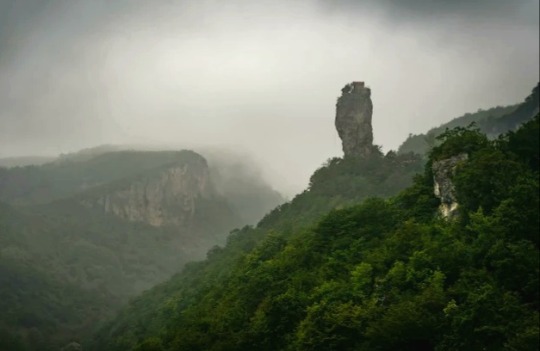
Sources & More Info:
BBC: Georgia's Daring, Death-Defying Pilgrimage
CNN: Katskhi Pillar, the Extraordinary Church where Daring Monks Climb Closer to God
Radio Free Europe: Georgian Monk Renews Tradition, Lives Atop Pillar
Architecture and Asceticism (Ch. 4): Stylitism as a Cultural Trend Between Syria and Georgia
Research Publication from the Georgian National Museum: Katskhi Pillar
Journal of Nomads: Katskhi Pillar, the Most Incredible Cliff Church in the World
Georgian Journal: Georgia's Katskhi Pillar Among World's 20 Wonderfully Serene and Secluded Places
#archaeology#history#anthropology#artifact#medieval architecture#medieval church#Stylites#asceticism#georgia#sakartvelo#katskhi pillar#religion#travel#monastery#paganism#caucasus#medieval europe#christianity#strange places
460 notes
·
View notes
Text
The Nestorian cross — with four arms, all of relatively equal length, wider at their ends than in the middle — was found all over Asia during the early middle ages, when Christianity thrived there. Here’s one from Turkmenistan:

And from Iraq:

Much more about medieval Christianity in Asia here:
{Buy me a coffee} {WHF} {Medium} {Looking Through the Past}
153 notes
·
View notes
Text
St. Maurice

Year/Time Range: supposedly lived 250-287 AD, earliest surviving depictions from the 12th century.
Basic Summary: St. Maurice was a Christian soldier, saint, and martyr. According to legend, he was born in Egypt and became a commander in the Roman army. Leading an all Christian legion, he was executed and martyred when he and his men refused to attack other Christians. He was made patron saint of many organizations and locations throughout the Middle Ages. Among these are the Holy Roman Emperors, the merchant order the Brotherhood of the Blackheads, and multiple towns in Germany, Italy, and Spain. He is also the namesake of the Swiss town St. Moritz.
Further Context/Commentary: Depictions of St. Maurice as a black African are common (though not ubiquitous) throughout the Medieval period. This fact is inconvenient for ideologies wishing to construct an idea of an all white Medieval Europe, and indeed depictions of St. Maurice in Coburg, Germany were removed under the Nazi regime (they were then restored after the war). It is clear why. Not only does Maurice’s depiction contradict the idea of an all white Medieval Europe, it also presents a black figure who was respected and venerated by Medieval Europeans.
Sources/Links:
Saint Maurice - Wikipedia
Maend_Black_Soldier_ICO_1_2014-libre.pdf (d1wqtxts1xzle7.cloudfront.net)
0 notes
Text

Etching print on a book plate, 1551 /// serpent absolutely chowing down on the hand of god
#old book#old art#illustration#witchy things#engraving#gothic#alchemy#occult#artwork#esoteric#medieval#renaissance#French#literature#witchy art#serpent#art#etching#line art#weird#dark fantasy#theology#obscure#religion history#archaic#archaeology#museum#art history#old gods#hermetic
74 notes
·
View notes
Text
two questions to ask yourself when you start looking for pre-christian material in medieval literature:
1. when are these texts from
2. when did christianity come to this area
i can guarantee you in the vast majority of celtic-language sources (and others) the answer to 2. is several centuries before 1. and at that point you gotta ask yourself... how likely is it that these people would be writing about something that has not been a thing for them or anyone they know for, like, four hundred years (or, in many cases, eight or nine hundred years), especially given that most of the people doing that writing are not merely passively existing in a christian society but are, yunno, monks
there are exceptions! but there are way fewer exceptions than you think there are gonna be! and the exceptions are almost always extremely nebulous sub layers that can't be disentangled from the other layers (which are christian) with any certainty so are always somewhat speculative!
and most importantly those other layers are interesting too, but if you only ever treat them like dirt to dig through to get to something "real" underneath you're sure gonna be disappointed a lot of the time (and you're gonna miss a lot of cool shit that would be really exciting if this was an actual archaeological dig and not a metaphor)!!
#this feels a bit like lobbing a grenade into a crowded theatre#but tbh everyone who is mad at me for saying this has probably already blocked me#given that I've been saying it for several years at this point#i think these days people are so used to religion being a personal thing#they don't really comprehend what it meant to Live In A Christian Society As A Medieval Person#like. we're not talking primarily about faith or what someone personally believed#but how society is structured and ordered and the paradigms its literature lives within#AND WHO PRODUCES THE LITERATURE#education is ecclesiastical. book production is ecclesiastical. literacy itself is in many cases ecclesiastical#the christianity is coming from inside the house#anyway whatever why am i trying#i had two (2) entire sips of wine this evening (i don't drink and don't like wine)#so maybe that's why i'm posting this lol
127 notes
·
View notes